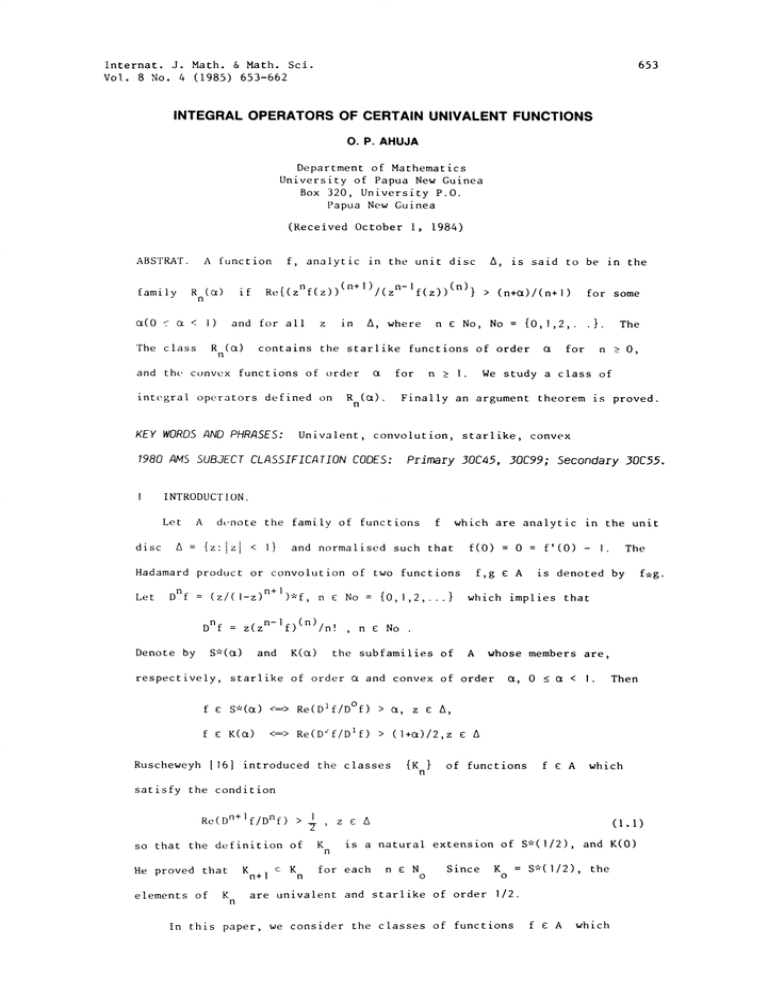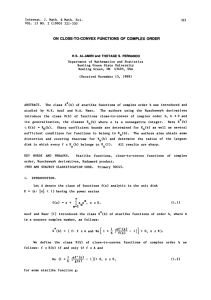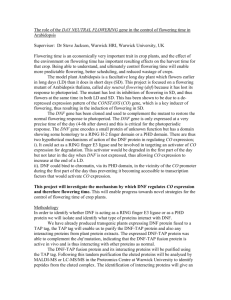Document 10485538
advertisement

Internat. J. Math. & Math. Sci.
Vol. 8 No. 4 (1985) 653-662
653
INTEGRAL OPERATORS OF CERTAIN UNIVALENT FUNCTIONS
O. P. AHUJA
Department of Mathematics
University of Papua New Guinea
Box 320, University P.O.
Papua New Guinea
(Received October I, 1984)
ABSTRAT.
A function
family
R ((z)
a(0
< I)
Re{(znf(z))(n+|)/(zn-;f(z)) (n)}
if
and for all
R (a)
The class
A,
f, analytic in the unit disc
in
z
A,
where
n e
is said to be in the
> (n+c,)/(n+l)
{0,I,2,.
No, No
contains the starlike functions of order
and the convex functions of order
R (a).
integral operators defined on
KEY WOROS ANO PHRASES:
n >_ I.
for
(
for some
a
}.
for
The
0
n
We study a class of
Finally an argument theorem is proved.
Univalent, convolution, starlike, convex
1980 AM5 SUBJECT CLASSIFICATION CODES"
Primary 50C45, 50C99; Secondary 50C55.
INTRODUCTION.
Let
A
d,note the
{z"
disc
Iz
< I}
family of functions
which are analytic in the unit
f
and normalised such that
f(0)
0
f,g
A
Hadamard product or convolution of two functions
Let
D
n
(z/(]-z)n+l)*f,
z(zn-]f)(n)/n!
Dnf
S*()
Denote by
and
K(e)
the subfamilies of
The
is denoted by
f,g.
which implies that
A
whose members are,
,
and convex of order
S*(e) <---->
Re(Df/Df)
> a, z
K(C)
Re(Df/Df)
>
<---->
I.
n e No
respectively, starlike of order
f
{0,1,2,...}
n 6 No
f’(0)
|.
Then
A,
(l+()/2,z
Ruscheweyh 116] introduced the classes
<
0
{K
A
f e A
of functions
which
satisfy the condition
Re(Dn+lf/Dnf)
>
so that the definition of
K
He proved that
elements of
K
n
n+
K
n
@
z e
K
n
A
(1.1)
is a natural extension of S*(|/2), and K(O)
for each
n
N
o
Since
K
S*(|/2)
o
the
are univalent and starlike of order /2.
In this paper, we consider the classes of functions
f
A
which
654
O.P. AHUJA
satisfy the condition
Re(z(Dnf) ’/Dnf)
a(0
for some
R (a)
a < ;)
S*(a)
were considered earlier
each
R (a)
n P 0
K(a)
for
and for each
n
definition (].2), restriction
each
0
partition
K
uR (a)
K
n
K
n
I)
K
We note that in
n
K(a)
n
permit us fully to
such that
Rn+] (a)
R (a)
for each
n
for each
n E N
S*(a)
o
family
every
F
I.
n
and an operator
and for
for each
An important problem in univalent functions is the following"
J
defined on
F
Given
J(f) E F
is
for
Libera []]] established that the operator
F
f
for
<<
R (a)
a compact
R (0)
n
(I-n)/2
These inclusion relations establish that R (a)
n
and
n
It is readily seen that for
n
(n
n
R
n
It can be easily seen that
n e 0
The classes
R (a)
n
We have
n
can be replaced by
R (a)
into classes
n
l-n
2
all
R (a)
and, further, that the negative choices of
n
.
a < I.
0
by Singh and Singh []71.
R (0)
n
(1.2)
We denote these classes by
R]()
and
O
A
> (, z
j(f)
2
g
fz
f(t)dt
O
preserves convexity, starlikeness, and close-to-convexity.
greatly generalised Libera’s results.
Bernardi [5]
Many authors [],2,7,8,]2,]5,]7]
studied operators of the form
z
j(f)
where
y
]+Y
zY
rJo tY-]f(t)dt
(1.4)
is a real (or complex) constant and
class of univalent functions from
A
f
Recently, operators
studied in more general form by Causey and White
Reade
[]4],
Barnard and Kellogg
[3],
belongs to some favoured
(|
4) have been
[6], Miller, Mocanu
and
and Bajpai [2]
In this paper, we study a class of integral operators of the form
(].4) defined on our family R (a)
n
We also obtain an argument theorem for
the class R ()
n
INTEGRAL OPERATORS.
2.
Let
be a complex number with
Re-I
We define
h
by
INTEGRAL OPERATORS OF CERTAIN UNIVALENT FUNCTIONS
. Y+!z
h (z)
Y
Let the operator
J’A
A
l+y /
F(
Jo
Y
Then the function
F
F(z)
z
A
z e
j=IY+J
655
be defined by
J(f), where
F
f(t)tY-ldt
(2.2)
can also we written in the form
f(z)*h (z)
Y
We need the following result of Jack [9] which is also due to
Suffridge [18]
LEMMA.
Let
Il
zf
aai
W’(Z
Z
O
ae
aium
kw(z
O
where
O
on h
is a real number and
k
We first give a condition on
belongs
n E
E A
0 <- C < I, and
Let
>_
then
>
k
for which the function
J(f)
](
# -I
+ 2((I +
be a complex constant such
Re]()
I.
If for a given
F(z)
(l-)(Ot+Re]()
e
2
]](I
(2.3)
+2tRe( +(la +(l-0t)
given by (2.2) belongs to
z(DnF(z))’+y DnF(z)
A
in
R (e).
n
DnF
w(z)
(](+l)Dnf(z).
(2.4)
by
z(DnF(z))
Here
ehn
0
From (2.2), we obtain
PROOF
Define
a
satisfies the condition
A,
z
I](I
O, and
z(Dnf(z) )’
Dnf( z
Re
for all
0
n
Re]( e-(, Im](
No,
A
E
< 1,w(O)
R (()
to
THEOREM I.
that
Izl< r
ci Il
be nonconstant and analytic in
w
z
l+(2-l)w(z)
l+w(z)
is analytic in
We need to show that
lw(z)l
A
with
<
(2.5)
w(O)
for all
0
z e
and
A.
w(z) # -I, z e A
In view of (2.4),
(2.5) yields
Dnf(z)
DnF
z
+]()+(2(- +y)w(z)
(I+]()(l+w(z))
Differentiating (2.6) logarithmically and simplifying, we obtain
(2.6)
O.P. AHUJA
656
z(Dnf(z))
Dnf(z)
e
lw(z)l
Now (2 7) should yield
exists a point
z w’(z)
z
kw(z
A
k
2( l-()zw’ (z)
(2.7)
1+w(z))(1+y+(2a-1+y)w(z))
]-w(z)
1+w(z
<
for all
ReZo(Dnf(zo) )’
for otherwise, there
Lemma
and by
For this value of
|.
A
z
,,lW(Zo)l
at which
O
O
O
(|-e)
z
z
we have
we find that (2 7) yields
O’
2k(1-a)(a+Rey)
a
(2.8)
]( l+y)+(ma-l+)W(Zo)]
Dnf(zo
(l-a)(e+Rey)
I] +2aRe +a +(l-a) Imy}
2
which contradicts (2.3)
z(Dnf(z))’
No,
n E
A
and by (2.5),
satist:ies the condition
(2.9)
A
z
2(y+(X)
l, 0
T+2a
{(a,y)
y # -!
If
IYI2+2e(l+Rey)
e
> -1}
a < 1,
Rn ()
given by (2.2) belongs to
PROOF.
z
is any point in the set
D
F(z)
A
E
2a(7+0)-(l-e))
>
Dnf(z)
(e,y)
then
for all
n
If for a given
COROLLARY.
where
<
F(z) e R ().
it follows that
Ro
lw(z)]
Hence
is a real constant such that
(y+l)(y+2e-1)
implies
0
+ e
0
then
The result follows
from Theorem
It is easy to show that if
(2 3).
R (a), then
n
Thus it follows from Theorem
that
satisfies the condition
J(R (a))
n
R (a)
More precisely
n
we state the result in
THEOREM 2
j(f)
If
R ()
f
y+l
z
"(
is again an element of
n
fz
f(t)
then the function
tY-ldt
o
R (a)
where y
# -I
is a complex constant with
restrictions as stated in Theorem I.
get
REMARK
Letting
L(S*(8))
S*((x) and
n
0
L(K(B))
and
K((X)
n
y
in Theorem 1, we
respectively, where
L
is the
Libera transform de fined in (|.3), and
B
((2(x2+3et-1)/2(l+et)) < a
These results improve the earlier results due to Libera [11] and Bernardi [5]
in the sense that their results hold under much weaker conditions
INTEGRAL OPERATORS OF CERTAIN UNIVALENT FUNCTIONS
In [2], Bajpai has established that
J(S*)
S*()
657
.
for some
We
generalize thls result in
THEOREM 3.
J’A
Let
complex constant
e R
If
2), where
be defined as in (2
A
J(f) e R (), where
then
n’
y
is a
satisfies the
n
inequality
ll+Yl+12-,+Yl
-< 2(l-O)(+Rey)
Re
z(Dnf(z)
Dnf(zo
0 -< Ot <
and applying Lemma, we have
Proceeding as in Theorem
PROOF
and
2(1-()((+ Rey)
l+y)+(2a-l+y)w(z o)
2(1-() (c+Rey)
(I 1+xl+12_+yl)
where
Roy
for
c R
by (2 5)
.
R (0).
n
it
J(f)
follows that
in
z
A
and
in the above theorem, then
fzf(t)dt
Thuswe have recovered a
O
result of Miller, Mocanu and Reade
REMARK 2
for all
n
(2/z)
L(f)
where
<
R ()
C
n=O=y-I
let
If
S*(]-3),
U(S*)
lw<z)l
Thus we must have
n
REMARK
O, we have a contradiction
Since the right hand side is
If
I,
n
y
([14], pp 162-163).
is a real constant such that
e K, then it follows from Theorem 3 that the function
F(z)
y+
O, and
in (2 2) is
K(), where
an element of
-(2X+I)
(
+
/(2y-l)=+8(l+y)
4
This result was proved by Miller, Mocanu and Reade ([|4], pp 165)
Further, this is an improvement of an earlier result due to Bernardi [5],
who proved that
n, where
y
For
E K
THEOREM 4.
E R
n
()
PROC F.
n e N
f(z) * h n (z)
then
F E R
n+l
n
z
n-1
dt
(2.10)
(n+l)Dn+If(z)
(2.11)
f(t)t
o
()
n+l
From (2. I0), we obtain
z(Dn+IF(z))
and
F e K
we have an improvement over Theorem 2
Let
F(z)
If
implies
nDn+IF(z)
O.P. AHUJA
658
z(DnF(z))
nDnF(z)
+
(n+|)Dnf(z)
(2.12)
Using the identity
(n+])Dn+|f(z)
z(Dnf(z))
nDnf(z)
(2.13)
in (2. ]]) and (2. 12), we obtain
(n+l)Dn+If(z)
(n+2)Dn+2F(z)
Dn+]F(z)
(2.14)
and
Dn+]F(z)
Dnf(z)
(2.15)
In view of the identity (2 ]3) and the relations (2. 14) and (2 15),
E R (()
n
yields
(n+2)Dn+2F(z) (n+])Dn+]F(z)}
Dn+]F(z)
Re
>
(
which implies that
z(Dn+IF(z))’}
Re
Dn+ 1F
This proves that
REMARK
>
z c A
(
z
F
For
n+]
O, Theorem 4 gives the well known result"
n
g
J(S*(())
K(C),
f (f(t)/t)dt
J(f)
where
o
We now investigate the converse of Theorem 2.
sharp radius of the disc in which
R (a)
is in
for
n
a <
0
f E R (8)
In [12]
I"
have solved this converse problem for the case
a
8 <
].
F
when
n
0 <
In fact, we find the
defined in (2 2)
Libera and Livingston
n
O, y
when
These authors were not able to obtain suitable results for the
complementary case when
-
< a
However, the method used in the
next
theorem gives results that are more general and also covers both
and
8 < a.
THEOREM 5.
F(z)
with
z
element of
F
l+y
z
A, Rey ->
R ()
n
for
R (a)
is an element of
If
for
n e 0
and
e a
a < I,
0
f(t)tY-Idt
a,
and
Izl
< r
0 -<
o
(2.16)
B
< 1, then the function
where
is an
is the smallest positive
r
0
root in (0,]) of the equation
(y+2a-l)(2a-B-1)r2+2((y+a)(a-B)-(l-a)(2-a))r+(y+l)(l-B)
The result is sharp
0
(2.17)
INTEGRAL OPERATORS OF CERTAIN UNIVALENT FUNCTIONS
PROOF
R (a), we can write
n
F
Since
z(DnF(z))’
DnF(z)
where
P (z)
ReP (z) > 0
for
n
a
(I-&)P (z),
n
A
analytic in
Is
n
659
A
z
z(DnF(z))
(2.18)
P (0)
and satisfies the conditions
n
Using the identity
nDnF(z)
(n+|)Dn+IF(z)
(2.19)
in (2.18) and then taking logarithmic derivative, we obtain
|-Ot)zP’
z(Dn+lF(z))
Dn+lF(z)ia+(1-ct)P
(z)
n
(z)
(2.20)
n+a+(l-a)P (z)
From (2 16) we obtain
z(Dn+lF(z)),
+
(y+l)Dn+lf(z).
yDn+lF(z)
(2.21)
From (2 20) and (2 21) we have
(y+l)Dn+If(z)
Dn+lF(z)
l-a)zp’ (z)
[a+y+(l-a)P n (z)
+
n
n+a+(l-0t)P
(z)]
(2.22)
Also (2. 18) together with the identity (2 4) yields
DnF(z)(a+y+(l-a)P n (z)).
(l+y)Dnf(z)
(2.23)
Now from the relations (2 22), (2 23), and (2.18) we conclude that
1-Ct)zP’ (z)
z(Dnf(z))’
Dnf(z)
8
a- 13
(l-a)P (z) +
n
n
(2.24)
Or+y+(1-Ot)Pn(Z)
Using the well known estimates
ZP’n(Z)l -<
(mr/(1-r 2))Rep (z)
n
and
ReP (z) -> (l-r)/(l+r)
n
Izl
r
in (2 24), we obtain
Re
where
z(Dnf(z))’
Dnf(z)
Rey e -a
Re
131
_>
(a-3) +
(l-S)(( l-r)(y+ l+(y+2a-1 )r)-2r)
1-r)((Y+2a-1 )r+T+l)
(2.25)
Therefore,
z(Dnf(z))
Dnf(z)
>
8
is positive, which is satisfied provided that
if the right side of (2.25)
root in (0,|) of (2. 17).
where r o is the smallest positive
r < r
o
with the function
The result in the theorem is sharp
f(z)
(1/(l+c))z
|-c
c
z F(z))
f
defined by
(2 26)
O.P. AHUJA
660
where
-a
c
Rey
z
(DnF(z))
DnF(z)
is given by
F
and
1-(2ot-1)z
(2.27)
|-z
a,B,y,
By specializing choices of
REMARK.
theorem 5 gives
and n
rise to the corresponding results obtained earlier in [3,4,8,|2,13,15]
and by many others
3
AN ARGUMENT THEOREM.
If
THEOREM 6
n
Dkf(zJ[_.
[’arg
k-1
2(l-a)sin-
z
k(O
for each
R (a), then
E
Z
r +
2(1-a)r
(m+ 1-(m+2a-
sin
m=O
)r
n+l).
k
We may write
PROOF
Dkf(z)
f_(
z
z
z)-- Dm+l
Dmf(z)
f(z)
0_< k< n+l
m= 0
which yields
arg
R
Since
m(O
m
n+
Dkf(z)
z
(a)
n)
R (a)
n
-<
Vn
[arg
c N
o
k-I
f(z)
F [arg
m=O
it follows that
l
z
+
Dm+l f(z)
(3.1)
Dmf(z)
f c R (a)
m
for each
Setting
Dm+|f(z)
qm(Z)
Dmf(z)
we note that
Re(qm (z))
(0 _< m _< n),
(3.2)
(m+cg)/(m+])
>_
Therefore, the function
w(z)
is analytic with
Lemma,
m+O)
(qm (z) m---"
m+a
(qm(Z) n--) +
qm(Z)(2(m+e_____)
qm(Z
m+
w(O)
0
and
(I
m----)
(I
m---$-)
m+Cx.
1)
lw(z)l
<
in
A
Hence by Schwarz’s
INTEGRAL OPERATORS OF CERTAIN UNIVALENT FUNCTIONS
qm(Z)qm(Z)+ 1- 2(m+a)/(m+l)
for
A
in
z
661
II
<
Now it is easy to see that the values of
qm(Z)
are
containod in the circle of Appolonius whose centre is at the point
(m+l-(m+2(-l)r2)/((l+m)(|-r2))
maxlarg
Thus
qm(Z)l
zeA
2(l-a)r/((m+l)(l-r2))
is attained at the points where
qm(Z)
arg
and has radius
sin
+/-
2( l-a)r
I(m+l_(m+2ct_l)r
which gives
D
larg
for
0
f c R ()
(.
2( 1-a)r
m+ I- (m+2(- )r
Applying (3 3)
F’(z)l
O,
n
K(a)
is in
(3.3)
S*(a)
f
and
But for
2(l-()sin-lr
-<
0
-< 2( l-a)sin
(3.4)
and
COROLLARY
S*(a)
n
f(z)
-q--I
larg
n
-1
K(a),
V
(Izl
if and only
we have
r)
implies
n
For
sin
R (a)
[(f(z)/z)dz
arg
Thus
-<
and z e A
note that
F(z)
if
f(z)
Dmf( z
m g n
Next
m+l
Ir
(3.1)
to
(3.4)
we obtain the result.
we obtain
f e S*(a), then (3.4)
If
and
larg
REMARK
f’ (z)
The case
2( 1-a)sin
n
O, a
r + sin
0
-1
2( 1-(l)r
l_(2a_l)r)
way proved by
Krzyz [I0].
The author is grateful to the referee for his suggestions which
greatly helped in presenting this paper in a compact form.
REFERENCES
1.
AL-AMIRI, H.S."
2.
BAJPAI, S.K
Certain generalizations of pre-starlike functions,
J. Australian Math. Soc (Serie A) 28(|979), 325-334
Spirallike integral operators, Internat. J. Math. &
Math. Sci., Vol 2 (!98|), 337-351.
662
O.P. AHULA
BARNARD, R W
and KELLOGG C."
Applications of convolution operators
J. 27
to problems in univalent function theory, Mich. Math
(1980), no I, 8]-94
4.
BERNARD1, S D." The radius of univalence of certain analytic functions,
Proc Amer Math. Soc 24 (]970), 32-38.
5
BERNARDI, S.D."
Math. Soc.
Convex and starlike univalent functions, Trans. Amer.
135 (1969), 429-446
CAUSEY, W.M and WHITE W.L." Starlikeness of certain functions with
integral representations, J. Math. Anal. Appl. 64 (978), 458-466.
7.
Univalent functions, Vol II, Mariner Publishing
GOODMAN, A.W
Company, Inc, 1983.
GUPTA, V P. and JAIN, P K."
di Mat
JACK,
9
On starlike functions, Rendiconti
(]976), 433-437.
S." Functions starlike and convex of order
Math Soc., _3(]97]), 469-474.
KRZYZ, J."
(, J. London
On the derivative of close-to-convex of order
Math. Soc., 3 (]971), 469-474.
11.
,
J. London
LIBERA, J.R."
Some classes of regular univalent functions, Proc. Amer
Math. Soc. 16 (1965), 755-758.
LIBERA, R.J. and LIVINGSTON, A.E." On the univalence of some classes
of regular functions, Proc. Amer. Math Soc. 3 (]97]), 327-336
LIVINGSTON, A.E." On the radius of univalence of certain analytic
functions, Proc. Amer. Math. Soc. 17 (1966), 352-357.
14
MILLER, S.S., MOCANU, P.T. and READE, MAXWELL O." Starlike integral
operators, Pacific J. Math. 79 (1978), 157-168
15.
PADMANABHAN, KoS."
On the radius of univalence of certain classes of
(1969), 225-231
analytic functions, J. London Math. Soc. (2)
RUSCHEWEYH, S."
Soc. 49
17.
]09-|15.
SINGH, R. and SINGH, S."
Proc. Amer
18
New criteria for univalent functions, Proc. Amero Math.
(1975),
SUFFRIDGE, T.J."
Math
Integrals of certain univalent functions,
(1979), 336-340.
Math. Soc. 77
Some remarks on convex maps of the unit disk, Duke
J. 37 (1970), 775-777





